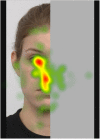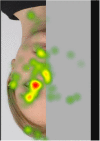Visual Fixation Patterns During Viewing of Half-Face Stimuli in Adults: An Eye-Tracking Study
- PMID: 30618923
- PMCID: PMC6297881
- DOI: 10.3389/fpsyg.2018.02478
Visual Fixation Patterns During Viewing of Half-Face Stimuli in Adults: An Eye-Tracking Study
Abstract
Human faces play a special role in social cognition, since as a core signal of interpersonal communication, they convey various kinds of information (e.g., about sex, age, race, emotions, intentions). Study 1 aimed to explore how this specialization manifests itself in eye movements when looking at neutral, static, female faces. We monitored the gaze pattern of 23 adult participants using eye-tracking method. To test if template-driven processes are involved in face perception, and to see how inversion affects fixations on special facial stimuli, we presented vertically cut half-faces in upright and inverted positions (so half of each stimulus represented a half-face, whereas the other half was left blank). Our results corroborate prior findings consistently demonstrating the dominance of the triangular area marked by the eyes and the mouth, measured by the number and duration of fixations. In addition, we found evidence for so-called complementary fixations, targeted at the non-informative parts (i.e., the half that does not contain any facial information) of the pictures, suggesting that other mechanisms beyond purely stimulus-driven ones might drive looking behavior when scanning faces. Study 2 was intended to test if these systematic eye movements are face-specific or occur in case of other visual objects as well.
Keywords: complementary fixations; face processing; face template; fixation patterns; inversion.
Figures













Similar articles
-
[Slowing down the flow of facial information enhances facial scanning in children with autism spectrum disorders: A pilot eye tracking study].Encephale. 2017 Feb;43(1):32-40. doi: 10.1016/j.encep.2016.02.005. Epub 2016 Mar 16. Encephale. 2017. PMID: 26995150 French.
-
Does face inversion qualitatively change face processing: an eye movement study using a face change detection task.J Vis. 2013 Feb 18;13(2):22. doi: 10.1167/13.2.22. J Vis. 2013. PMID: 23420421
-
How do monkeys view faces?--A study of eye movements.Exp Brain Res. 2003 Jun;150(3):363-74. doi: 10.1007/s00221-003-1429-1. Epub 2003 Apr 18. Exp Brain Res. 2003. PMID: 12707744
-
Mechanisms of face perception in humans: a magneto- and electro-encephalographic study.Neuropathology. 2005 Mar;25(1):8-20. doi: 10.1111/j.1440-1789.2004.00603.x. Neuropathology. 2005. PMID: 15822814 Review.
-
Magnetoencephalographic study on facial movements.Front Hum Neurosci. 2014 Jul 29;8:550. doi: 10.3389/fnhum.2014.00550. eCollection 2014. Front Hum Neurosci. 2014. PMID: 25120453 Free PMC article. Review.
Cited by
-
Evaluation of Fixational Behavior throughout Life.Brain Sci. 2021 Dec 24;12(1):19. doi: 10.3390/brainsci12010019. Brain Sci. 2021. PMID: 35053764 Free PMC article.
References
-
- Dyer A., Vassallo S. (2011). Eye Movements Reveal Novel Top-Down Saccade Processing for Face Stimuli; EyeTrackBehaviour – Tobii Eye Tracking Conference on Behavioural Research. Frankfurt: Clinical Centre of Johann Wolfgang Goethe University.
LinkOut - more resources
Full Text Sources

